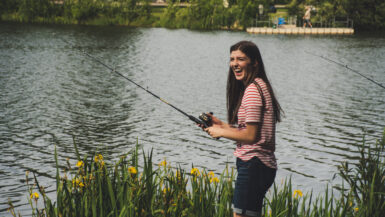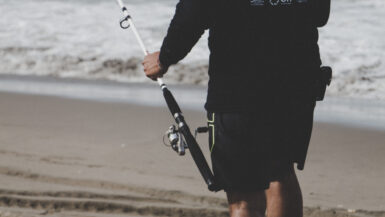Fishing is a beloved pastime for anglers of all ages. Freshwater fishing can be an especially exciting challenge for the experienced sportsman. Knowing the best bait for freshwater fishing can make the difference between a successful catch and an empty line. Whether you are a novice or an experienced angler, this article will educate you on the top three baits for freshwater fishing: live bait, artificial lures, and more. We will explain how each type of bait works, when to use it, and more. Read on to learn about the best baits for freshwater fishing.
Live Bait
The use of live worms and insects as bait is arguably the most popular and effective method of freshwater fishing. Live bait not only comes in many different sizes and colors, but also it mimics the natural food source of fish. Live bait such as worms and minnows can be found in most bait shops, and when well prepared, can be extremely effective.
When dealing with live bait, one important thing to remember is that the bait you choose should closely resemble the type of fish you’re targeting. Worms, for example, are a great choice for catching panfish, but you may need to have a larger bait for larger game fish, such as bass.
How to Prepare Live Bait for Freshwater Fishing
In order to get the most out of your live bait, it is important that you know how to prepare it before you go fishing. For worms, you want to make sure they are firm and lively, as limp worms can be ineffective. You can keep live worms in the fridge in a container with moist soil or sand. For other types of bait, such as maggots and larvae, it is helpful to keep them in jars or containers filled with water to keep them from drying out.
Best Practices for Using Live Bait for Freshwater Fishing
When using live bait, it is important to keep a few things in mind. Make sure to hook the bait correctly so that it is properly presented to the fish. You should also keep your bait in the best possible condition by refreshing it on a regular basis. Finally, if you’re going to be fishing in a shallow area, use a smaller size hook to avoid snagging the bottom.
By preparing and using the right bait, you can maximize the chances of a successful catch while freshwater fishing. With the right know-how and the right equipment, live bait can be one of the best freshwater fishing baits around.
Artificial Lures
When it comes to artificial lures, plastic worms and soft baits are some of the most popular. They can be a great option for catching a variety of trout, bass, and panfish species. Plastic worms and soft baits offer the advantage of being able to be used in a variety of ways and in a variety of conditions. You don’t need to worry about the bait dying or getting eaten quickly like with live bait, so you can leave it in an area for a longer period of time.
Most plastic worms and soft baits are manufactured with scents, flavors, and other fish attracting features. These can be a great way to draw fish in and get them to strike. It also means that you don’t have to rely on live bait to get the same effects. Many anglers find that using artificial lures like these is even more successful than using live bait.
Using Spinnerbaits and Spinners
If you’re looking for a lure that can cover a lot of water quickly, then spinnerbaits and spinners are worth checking out. They can be especially useful when you’re trying to cover a larger area and catch more fish. While spinnerbaits and spinners don’t look especially natural, they do a great job of attracting fish due to the combination of movement, noise, and vibration they produce.
Spinnerbaits and spinners come in a variety of sizes, shapes, and colors, so you can always find something that matches the size and color of the baitfish in the area. You can also add a trailer, such as a rubber or plastic worm, for added attraction.
Using Jigs and Jigging Lures
Jigs and jigging lures are another popular option for artificial lures. These lures are weighted and shaped so that they resemble a baitfish or other prey. You can get them in a variety of sizes, shapes, and colors, making it easy to find one that matches the size and color of the baitfish in the water.
Jigs and jigging lures usually have an attached hook, so you don’t need to use a separate hook like you do with some other types of lures. They’re most effective when used in combination with live bait, as the weight of the jig allows the bait to move naturally. This can help to increase their effectiveness and make them even more attractive to the fish.
Using Crankbaits and Other Lures
Crankbaits, jerkbaits, and swimbaits are other popular artificial lures that you can use. Crankbaits are designed to resemble baitfish, while jerkbaits and swimbaits are designed to look more like larger prey items. All of these lures can be used in a variety of ways, but they’re most effective when used in combination with live bait. This helps to increase their effectiveness and make them more attractive to the fish.
No matter which artificial lures you choose to use, it’s important to remember that they will never be as effective as live bait. However, they can definitely help to increase your catch rate, so it’s worth giving them a try. With the variety of lures available, you’re sure to find something that works for you.
Natural Baits
Using live bait for freshwater fishing is one of the most common methods for catching a variety of different species. Live bait can be anything from worms, slugs, crickets, minnows, frogs, and even leeches. Live bait is best for catching panfish, catfish, and bass, but many different species can be attracted to various types of live bait. When choosing a live bait, it is important to consider the type of fish you want to catch and the kind of bait they prefer. For example, catfish prefer a more oily bait while bass prefer a more natural bait. Additionally, bait should be freshly acquired – as live bait begins to die, the effectiveness of it decreases.
Natural Baits
Natural baits are a great option for freshwater fishing, as they often create a more natural, attractive look for fish. Examples of natural baits include maggots, leeches, waxworms, grasshoppers, crayfish, and mealworms. Natural baits require a little bit more knowledge and skill to work with, as the angler must identify the type of bait that a fish is drawn to and present it in an enticing way. This kind of bait also must be checked regularly to ensure that it is still fresh, as stale or dead bait will not be as effective. Natural baits, when used correctly and with the right species of fish, can be a great way to catch a wide range of fish.
Artificial Lures for Freshwater Fishing
Using artificial lures for freshwater fishing is one of the most popular methods for catching many species of fish. Artificial lures come in a wide variety of shapes, sizes, and colors and can be used to entice fish by imitating the actions and appearances of live bait. Artificial lures can be used to target larger panfish, bass, and even trout. When choosing an artificial lure, anglers should consider the type of fish they are seeking and the type of lure they prefer. Additionally, anglers should be aware of the various types of artificial lures and the ways in which they can be used to target different types of fish.
Preparing and Presenting Freshwater Baits
Preparing and presenting freshwater baits is an important part of angling, as the presentation of bait will have a direct impact on the chances of catching fish. Proper presentation is key to catching fish, no matter what type of bait is used. When presenting a bait, anglers should consider the type of fish they are targeting and the type of bait they are using. Additionally, anglers should consider the water conditions, the type of tackle being used, and the size and shape of the bait itself. With the right preparation and presentation, anglers can maximize their chances of success when fishing with live bait, natural baits, and artificial lures.
Fly Fishing
Fishing with artificial lures is a popular and often successful way of catching freshwater fish, as it requires minimal equipment and can be used in many different water conditions. Artificial lures come in a variety of shapes and sizes, such as spinnerbait, crankbait, and soft plastic, and are made to imitate the appearance of a live baitfish. Artificial lures often work best when they are retrieved in an erratic manner so that they appear to be struggling like a wounded baitfish.
Trying Out Fly Fishing
Fly fishing is a unique type of angling that uses a long rod and specialized fishing lines with weights and artificial lures designed to imitate insects. Fly fishing can be highly effective for catching trout, bass, and other species of freshwater fish. Experienced fly fisherman must learn the proper fly fishing technique, which involves casting the line in close proximity to the fish, as well as being able to accurately identify the types of bugs and lures that are attractive to fish.
Preparing with Live Bait
Live bait is one of the most commonly used baits for freshwater fishing and is often the best choice for novice anglers. Live bait is versatile and can be used in many different fishing situations. Popular live baits include nightcrawlers, crickets, and minnows. Live bait also tends to appeal to larger fish species such as catfish and bass. When using live bait, it’s important to keep the bait alive and to make sure it stays on the hook until a fish strikes.
Exploring Other Baits
In addition to the baits and lures mentioned, there are a few other bait options worth trying when freshwater fishing. Cut bait, such as chunks of fish flesh, can be an effective attractor for certain species, such as catfish. Dough baits and scented baits are also sometimes used in freshwater angling and these can be effective when used correctly.
Finding the Right Bait
The key to successful freshwater fishing is finding the right bait for the type of fish you’re trying to catch. Live bait and artificial lures are the two most common baits used, but a range of other options are also available. It can be helpful to try a variety of baits to determine which one works best. With experience and knowledge, anglers can quickly become experts in their freshwater fishing techniques and land plenty of prize catches.
Other Considerations
When selecting the best bait for freshwater fishing, it’s important to take into account the conditions of the water you are fishing in. The type of water, current, depth, temperature, and visibility can all have an effect on which bait will be most effective. Generally, live bait tends to work best in clear and shallow waters, while artificial lures are better for fishing in deeper waters and in murky conditions.
Safety Concerns
When using live bait, it’s important to follow safe fishing practices. Make sure to never handle live bait without wearing protective gloves and always follow safety guidelines when handling live bait and fishing equipment. Artificial lures are generally safe to use, but anglers should be sure to check for sharp edges and any loose hooks that may come off of the lure itself.
Cultivating the Right Technique
Regardless of the type of bait you use, it’s important to have the right technique when fishing. When using live bait, it’s important to make sure it’s presented properly and that it looks natural in the water. When using artificial lures, anglers should be sure to properly cast the bait and use the right retrieve technique for the type of lure being used.
Selecting the Right Fishing Line
The type of fishing line used will also have an impact on the effectiveness of the bait in the water. When using artificial lures it’s important to choose a line that isn’t too heavy or too light, as this can affect the action of the lure. With live bait, heavier line tends to work better, as the bait can be reeled in without breaking the line.
Storage and Maintenance
When keeping live bait, it’s important to store it properly and keep it in the right conditions. Artificial lures should also be checked regularly for damage, as they can easily become damaged from regular use. Regular maintenance and care for both types of bait will help ensure that they are effective when used for freshwater fishing.
Reap the Benefits of Different Bait Types for Maximum Effectiveness in Freshwater Fishing
We all know the importance of the bait when it comes to fishing. Live bait, artificial lures, and other bait types can all be used to effectively and efficiently catch fish in freshwater. Live bait is the most popular choice, and includes worms, minnows, frogs, and other small creatures. These can not only attract a greater variety of fish, but can also mimic the behavior of their natural prey. Artificial lures provide the added benefits of sparkle and motion, attracting fish with their vibrating movements and irresistible colors. Lastly, dough bait, salmon eggs, and other species specific baits are each sure to make a great catch with the right color and flavor combinations. Whatever the choice, it is always important to remember that proper presentation of the bait is key. With the correct technique and bait, freshwater fishing can be a rewarding and enjoyable experience.





Leave a reply